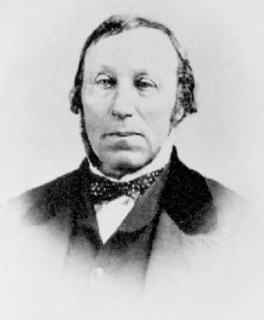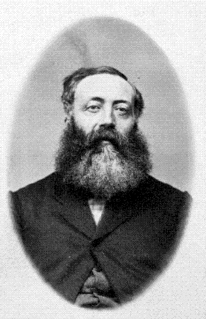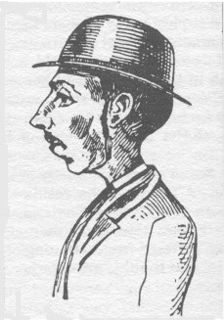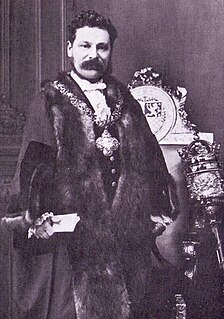
Carter Henry Harrison Sr. was an American politician who served as mayor of Chicago, Illinois, from 1879 until 1887; he was subsequently elected to a fifth term in 1893 but was assassinated before completing the term. He previously served two terms in the United States House of Representatives. Harrison was the first cousin twice removed of President William Henry Harrison, whose grandson, Benjamin Harrison, had also been president until just months prior to the assassination. He was also the father of Carter Harrison Jr., who would follow in his father's footsteps, and would serve five terms as the mayor of Chicago himself.

John Robson was a Canadian journalist and politician, who served as the ninth premier of British Columbia.

Frederick Seymour was a colonial administrator. After receiving little education and no inheritance from his father, Seymour was offered a junior appointment in the colonial service by Prince Albert. Seymour held positions in various British colonies from 1842 to 1863, when he returned to England

Hugh Nelson was a Canadian parliamentarian and the fourth Lieutenant Governor of British Columbia.

The Chilcotin War, the Chilcotin Uprising or the Bute Inlet Massacre was a confrontation in 1864 between members of the Tsilhqot'in (Chilcotin) people in British Columbia and white road construction workers. Fourteen men employed by Alfred Waddington in the building of a road from Bute Inlet were killed, as well as a number of men with a pack-train near Anahim Lake and a settler at Puntzi Lake.
William George Cox was Gold Commissioner for the Cariboo and Boundary Districts in the Colony of British Columbia, Canada during the Rock Creek Gold Rush. He was born in Ireland.
John Tannatt Ussher, usually known as Johnny Ussher, was a settler, provincial magistrate and Gold Commissioner in the Thompson Country of the Southern Interior of British Columbia, Canada in the 1870s. John Tannatt Ussher was the son of Samuel Ussher Esq., a lawyer in Montreal, and Harriet Rebecca Colclough. He was born October 17, 1830.

Sir Henry Pering Pellew Crease was a British-Canadian lawyer, judge, and politician, influential in the colonies of Vancouver Island and British Columbia. He was the first Attorney General of the united Colony of British Columbia, and sat on the Supreme Court of that province for 26 years.
Pitt Lake's Lost Gold Mine is a legendary lost mine said to be near Pitt Lake, British Columbia, Canada, the supposed wealth of which has held the imagination of people worldwide for more than a century. Ever since the years of the Fraser Canyon Gold Rush prospectors and adventurers have been looking for the mine and gold-rush rumors have evolved into legends repeated and enriched over time. The mysterious riches are known as Slumach’s Lost Mine, or Lost Creek Mine.

Percy Lefroy Mapleton was a British journalist and murderer. He was the British "railway murderer" of 1881. He is important in the history of forensics and policing as being the subject of the first police composite picture to appear on a "wanted" poster and in a newspaper.

Wynne Edwin Baxter FRMS FGS was an English lawyer, translator, antiquarian and botanist, but is best known as the Coroner who conducted the inquests on most of the victims of the Whitechapel Murders of 1888 to 1891 including three of the victims of Jack the Ripper in 1888, as well as on Joseph Merrick, the "Elephant Man".

Daniel Charles Shay was an American professional baseball shortstop, manager and scout in the late 19th and early 20th centuries. Shay's baseball career was relatively mediocre, and he is probably most remembered for being acquitted in the shooting death of a black man in 1917.

Elmer H. Fisher was an architect best known for his work during the rebuilding of the American city of Seattle after it was devastated by fire in 1889. He began his career as a carpenter and migrated from Massachusetts to the Pacific Northwest, where he practiced architecture from 1886 to 1891. After his reputation was damaged by litigation and personal scandal in Seattle, he relocated to Los Angeles in 1893, where he only had modest success as an architect before returning to carpentry, dying around 1905 with his final years almost as mysterious as his early years; the details of his death and his burial location remain unknown. His commercial building designs played a major role in reshaping Seattle architecture in the late 19th century and many still survive as part of the Pioneer Square Historic District.
John Cunningham Brown was an Irish-born newspaper owner and political figure in British Columbia. He represented New Westminster City in the Legislative Assembly of British Columbia from 1890 to 1894 and from 1900 to 1901.

HMS Grappler was an Albacore-class gunboat of the Royal Navy. She served on what is now the British Columbia Coast from 1859 until sold into commercial service in 1868. She sank with significant loss of life as result of a fire in 1883.
Athelstan Braxton Hicks was a coroner in London and Surrey for two decades at the end of the 19th century. He was given the nickname "The Children's Coroner" for his conscientiousness in investigating the suspicious deaths of children, and especially baby farming and the dangers of child life insurance. He would later publish a study on infanticide.

Jim Taylor was an African-American man who was lynched on April 30, 1891 in Franklin, Tennessee.
Capital punishment was abolished in 1957 in Alaska. Between December 28, 1869, and April 14, 1950, between the Department, District, and Territory of Alaska, twelve felons, all male, were executed by hanging for murder, robbery, and other crimes. Some were European, some were Native American, and two were African. The territorial legislature abolished capital punishment in 1957 during preparations for statehood, making Alaska the first in the West Coast of the United States to outlaw executions, along with Hawaii, which did the same.
Winston Pounds was an African-American man who was lynched by a mob in Wilmot, Arkansas, on August 25 or 26, 1927.